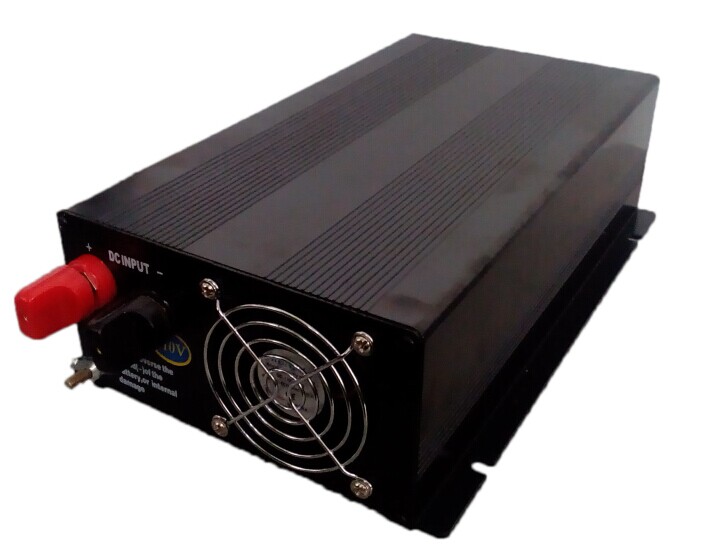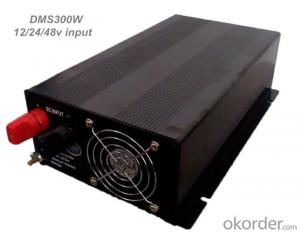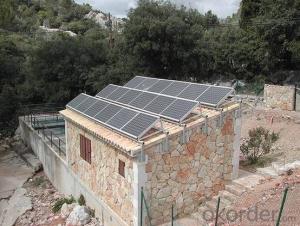Pure Sine Wave Solar Inverter 300W High Efficiency 12V/24V/36V/48V Input
- Loading Port:
- Qingdao
- Payment Terms:
- TT or LC
- Min Order Qty:
- 1 pc
- Supply Capability:
- 800 pc/month
OKorder Service Pledge
OKorder Financial Service
You Might Also Like
Specifications
1.Pure sine wave output(<2%THD)
2.High Efficiency 87%-90%
3.High motor start driven force
4.Function of battery protection

Product characteristic:
1.Pure sine wave output(<2%thd)< span="">
2.Input & Output fully isolation design
3.High Efficiency 87%-90%
4.High motor start driven force
5.5-stage thermal control fan
6.Function of battery protection
Technical Parameters:
Model | DMS300-12 | DMS300-24 | DMS300-36 | DMS300-48 |
Continuous output power | 300W | 300W | 300W | 300W |
Max power output | 320W | 320W | 320W | 320W |
Peak instantaneous power | 600W | 600W | 600W | 600W |
Conversion efficiency | ≥87% | |||
No -load current | 0.65A | 0.33A | 0.22A | 0.17A |
Output AC Voltage | 220/230/240/110/120/130V +5% | |||
Output wave form | Sine wave < 2%THD | |||
Frequency output | 50/60Hz+2% | |||
Input Dc Voltage | 10-16VDC | 20-30VDC | 30-45VDC | 40-60VDC |
Fault display | Red lamp flickers and buzzer alarms | |||
Working temperature | -20~55°C | |||
Function of protection | Alarm and protection in over loading, over voltage, low voltage, short circuit, over heating and converse connection, etc. | |||
Fan | Thermal control | |||
Product measurement(mm) | 265*140*81 | |||
Pack measurement(mm) | 340*165*140 | |||
Net weight | 2.6Kg | |||
Gross weight | 2.8Kg | |||
Application:
Electric tools:fretsaws, drills, mullers, grinder wheels, mowers, air compressors, etc.
Office equipment:computer, facsimile machines, scanners, etc.
Kitchen appliances:microwave oven, refrigerators, blenders, soybean juice machine, coffee makers, ovens, etc.
Lighting instruments: high pressure sodium lamp, compact fluorescent light, daylight lamp, halogen light, etc.
Home entertainment electronics:TV, blower, vacuum cleaners, fans, video games, musical instrument, charger, etc.
Payment Terms:
T/T, West Union,Money Gram, Paypal
Express Delivery:
EMS, DHL, FedEx, TNT, UPS
FAQ:
Q1:Can we visit your factory?
A1:Sure,welcome at any time,seeing is believing.
Q2:Which payment terms can you accept?
A2:T/T,L/C,Moneygram,Paypal are available for us.
- Q:How does the efficiency of solar panels vary based on the angle and orientation?
- The efficiency of solar panels varies based on the angle and orientation as they receive maximum sunlight when they are positioned perpendicular to the sun's rays. Panels that are tilted towards the sun at the optimal angle can capture more sunlight, resulting in higher efficiency. Incorrect angles or orientations can lead to reduced sunlight absorption and lower efficiency.
- Q:Are there any safety concerns with solar energy systems?
- Yes, there are some safety concerns associated with solar energy systems. The most common safety concern is the risk of electrical shock or fire due to improper installation or maintenance of the system. Additionally, solar panels contain toxic substances, such as lead and cadmium, which can be harmful if not handled or disposed of properly. However, with proper installation, regular inspections, and adherence to safety guidelines, these concerns can be minimized, making solar energy a safe and viable option for renewable power generation.
- Q:How long does it take for a solar energy system to pay for itself?
- The payback period for a solar energy system varies based on several factors such as the initial cost, location, energy usage, and available incentives. On average, it takes around 5-10 years for a residential solar energy system to pay for itself through energy savings. However, this timeframe can be shorter in areas with high electricity costs and substantial government or utility incentives.
- Q:What is the role of solar energy systems in reducing noise pollution?
- Solar energy systems play a significant role in reducing noise pollution as they operate silently without the need for any mechanical parts or combustion. Unlike traditional energy sources like generators or power plants, solar panels generate electricity through the absorption of sunlight, eliminating noise emissions. This not only provides a quieter and more peaceful environment for nearby communities but also has a positive impact on wildlife, reducing disturbances caused by loud machinery or industrial processes.
- Q:Can solar energy systems be used in urban environments?
- Yes, solar energy systems can be used in urban environments. In fact, urban areas provide ample opportunities for the installation of solar panels on rooftops, facades, and even on the ground. Solar energy systems can be integrated into buildings, parking lots, and streetlights, making use of available space to generate clean and renewable energy in densely populated areas. Additionally, advancements in solar technology have made it possible to optimize energy production even in limited or shaded urban areas.
- Q:What is the role of solar energy forecasting in grid integration?
- The integration of solar power into the electrical grid relies heavily on solar energy forecasting. Accurate predictions of solar power generation are essential for grid operators and energy market participants to effectively manage the integration process. Due to its dependence on weather conditions and the position of the sun, solar energy is intermittent and variable. Therefore, precise forecasting is crucial in helping grid operators anticipate fluctuations in solar energy supply and plan accordingly for any imbalances between supply and demand. The successful integration of solar energy into the grid requires a balance between the variability of solar power generation and overall electricity demand. Solar energy forecasting plays a critical role in this by providing real-time predictions of solar output. This allows grid operators to make necessary adjustments to other sources of power generation or storage to maintain grid stability. In energy markets, solar energy forecasting is vital for optimizing trading strategies and determining the optimal dispatch of power generation assets. Accurate forecasts enable energy market participants to effectively manage their portfolios and reduce the cost of integrating solar energy into the grid. This ultimately enhances the overall economics of renewable energy. Furthermore, solar energy forecasting contributes to the efficient operation of grid infrastructure. By providing accurate predictions of solar power generation, grid operators can plan the deployment and operation of transmission and distribution infrastructure. This ensures that the infrastructure can handle the increasing penetration of solar energy without compromising grid reliability. In conclusion, solar energy forecasting is crucial in grid integration. It enables accurate predictions of solar power generation, allowing for effective management of the integration process, optimization of energy trading strategies, maintenance of grid stability, and efficient operation of grid infrastructure.
- Q:Can solar panels be integrated into building materials like windows or roofing tiles?
- Yes, solar panels can be integrated into building materials such as windows or roofing tiles. This integration is known as building-integrated photovoltaics (BIPV), and it allows solar energy to be generated while seamlessly blending with the building's design. BIPV solutions are increasingly being used to enhance energy efficiency in buildings and promote sustainable practices.
- Q:Are solar energy systems noisy?
- No, solar energy systems are generally quiet as they do not involve moving parts or combustion processes.
- Q:Can solar energy systems be used in areas with high winds?
- Yes, solar energy systems can be used in areas with high winds. However, it is important to design and install the systems properly to withstand the wind forces. Special mounting and anchoring techniques are used to ensure the stability and durability of the solar panels and other components. Additionally, selecting the right type of solar panels and considering wind load calculations can help optimize their performance in windy conditions.
- Q:Can solar energy systems be used for powering off-grid oil platforms?
- Yes, solar energy systems can be used for powering off-grid oil platforms. Solar panels can be installed on the platforms to harness sunlight and convert it into electrical energy. This renewable energy source can be used to power various equipment and systems on the platform, reducing the dependency on traditional fossil fuel generators. Additionally, solar energy systems can provide a cost-effective and environmentally friendly alternative for powering off-grid oil platforms.
1. Manufacturer Overview |
|
|---|---|
| Location | |
| Year Established | |
| Annual Output Value | |
| Main Markets | |
| Company Certifications | |
2. Manufacturer Certificates |
|
|---|---|
| a) Certification Name | |
| Range | |
| Reference | |
| Validity Period | |
3. Manufacturer Capability |
|
|---|---|
| a)Trade Capacity | |
| Nearest Port | |
| Export Percentage | |
| No.of Employees in Trade Department | |
| Language Spoken: | |
| b)Factory Information | |
| Factory Size: | |
| No. of Production Lines | |
| Contract Manufacturing | |
| Product Price Range | |
Send your message to us
Pure Sine Wave Solar Inverter 300W High Efficiency 12V/24V/36V/48V Input
- Loading Port:
- Qingdao
- Payment Terms:
- TT or LC
- Min Order Qty:
- 1 pc
- Supply Capability:
- 800 pc/month
OKorder Service Pledge
OKorder Financial Service
Similar products
New products
Hot products
Hot Searches
Related keywords





























